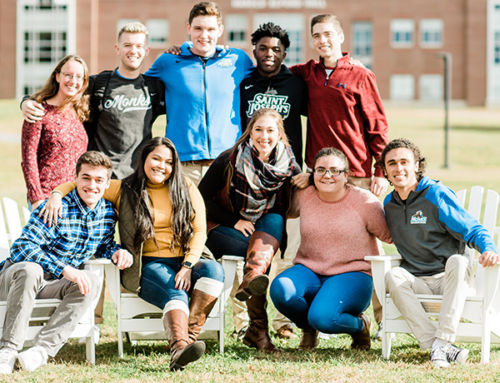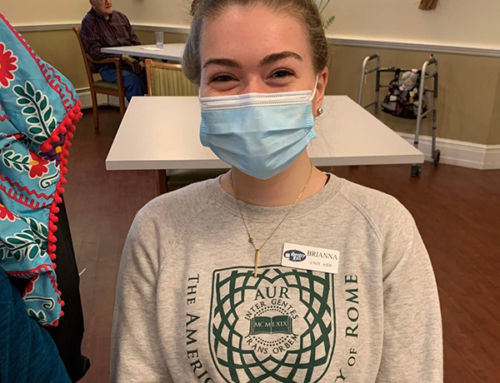Faculty Special Feature
Saint Joseph’s is about growing community. But we don't just grow it here in Maine. Through our International Service Trips, our faculty and students make a difference in the lives of others around the world.
For more than a decade, Dr. Steven Bridge has brought students on trips to Guatemala and Haiti through Partners in Development (PID). In 2014, he transformed his passion for geology—specifically gem cutting—into a small business initiative for Haitian individuals living in extreme poverty. Haiti doesn’t have a strong mining industry, but it has lots of discarded shards of glass. The colors of glass often resemble precious and semi-precious gemstones. Steve saw this as an opportunity, and began teaching Haitians to make their own jewelry.
Below Steve explains the process of setting up the SJC Lapidary Arts Center & Small Business Initiative in Blanchard, Haiti.
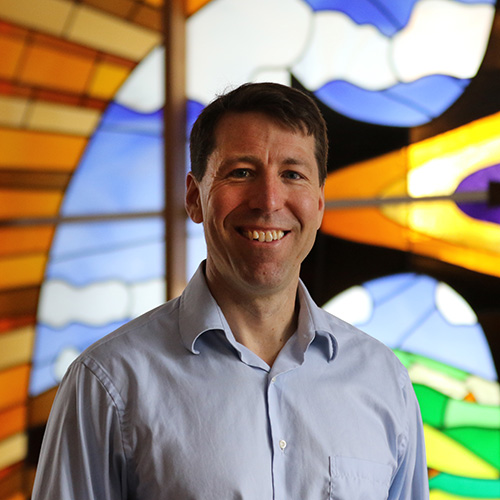
Dr. Steven Bridge
Theology Professor
“We have developed a highly resilient, economically sustainable, and environmentally friendly small business enterprise.… And we have modeled true advocacy for the marginalized—the victims of geo-political, racial, and gender inequities.” — Dr. Steve Bridge
By Dr. Steven L. Bridge, theology professor
In January of 2014, I packed up my faceting machine and brought it down with me to Haiti. I did so with the blessing and support of Partners In Development (PID), a non-profit organization with whom Saint Joseph’s College (SJC) already had a 10-year history of International Service Trips. My goal was to try to start a small business initiative for individuals living in extreme poverty. PID recruited eight volunteers and a translator, and I spent a week introducing them to the basics of gem cutting. We worked in a very small (broom-closet sized) concrete depot on the premises of the PID compound in Blanchard. It was mosquito-infested, cramped, and not well-lit, but it was a secure space to store all of the relatively expensive equipment involved. PID’s entire compound is solar-powered, so there was no cost to run the machine. As for raw materials, Haiti has very little industrial mining, but what they do have is an awful lot of garbage. I hit upon the idea of using discarded shards of glass as a viable source of production. The colors available often resemble well-known precious and semi-precious gemstones, including diamonds, emeralds, tourmalines, aquamarines, sapphires, smoky quartzes, amethysts, citrines, etc. Indeed, in most cases, only an expert can distinguish our finished products from their more valuable counterparts.
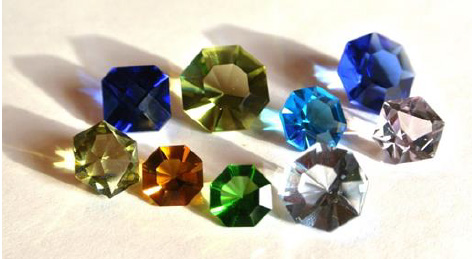 At the end of my trip, I deliberately left my machine down in Haiti so that my crew of gem cutters would have something to work with and practice on. Over time, the Haitians became quite adept at producing a limited number of basic shapes and styles of gemstones. These are shipped stateside, where they are set into jewelry and sold online. They’ve proven to be quite popular; PID has sold hundreds of pieces and has generated thousands of dollars in net revenue. Meanwhile, this initiative garnered a lot of positive press and earned some coveted awards. It was featured on the television show, 207, and it became the basis for both the St. Joseph College’s Instructional Innovation in Community-Based Learning Award in 2014 and the Maine Campus Compact’s Donald Harward Faculty Award for Service-Learning Excellence in 2015.
At the end of my trip, I deliberately left my machine down in Haiti so that my crew of gem cutters would have something to work with and practice on. Over time, the Haitians became quite adept at producing a limited number of basic shapes and styles of gemstones. These are shipped stateside, where they are set into jewelry and sold online. They’ve proven to be quite popular; PID has sold hundreds of pieces and has generated thousands of dollars in net revenue. Meanwhile, this initiative garnered a lot of positive press and earned some coveted awards. It was featured on the television show, 207, and it became the basis for both the St. Joseph College’s Instructional Innovation in Community-Based Learning Award in 2014 and the Maine Campus Compact’s Donald Harward Faculty Award for Service-Learning Excellence in 2015.
In 2016-17, I applied for the Faculty Professorship Award (FPA) in the hopes that it would enable us to take this small business to the next level. I envisioned building a new facility, adding more machines, hiring more workers, increasing production, and strengthening our brand. All of these things we accomplished…and so much more. However, I’ll be the first to admit that not everything went as planned. As I noted in my original proposal: “In a place like Haiti, feasibility analysis is notoriously challenging because of the high number of unpredictable variables, including political instability, natural disasters, infrastructure reliability, personnel problems, security, spotty transportation, public health crises, broken supply chains, bureaucratic red tape, etc., etc., etc.” This remark came from my own 25 years of personal experience in Haiti, and it proved to be somewhat prophetic. This project was hampered by political instability, personnel problems, security, spotty transportation, broken supply chains, and an unprecedented public health crisis. Nevertheless, we prevailed. More than that, I’m happy to report that several outcomes actually exceeded my original expectations. Despite all of the challenges that we faced—or maybe precisely because of them--I’m especially proud of what we achieved. So without further ado, permit me to walk you through these past 3 years:
Academic Year 2017-18
The Lapidary Arts Center
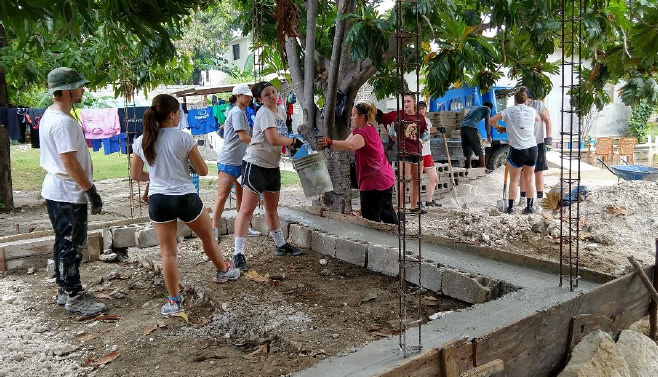 In December of 2017 and January of 2018, I led back-to-back teams of SJC students to Haiti. The FPA covered the cost of construction materials, and our SJC students contributed much of the “sweat equity” needed to build the new SJC Lapidary Arts Center (LAC). The LAC was built on the grounds of PID’s compound in Blanchard, Haiti. Ultimately completed in April of 2018, the LAC is a 20’ x 12’ concrete and cinder block building. It features generous indoor lighting and electrical outlets at four workstations, with ample shelving for each of the lapidary machines and their associated equipment. It also has bench seating around a large central island table, which workers use as overflow space to trim rough, affix and transfer gems, collaborate on designs, learn new techniques, etc. Although the LAC is located in a relatively secure compound, for added security we installed a double-lock solid iron door and iron bars on its two windows.
In December of 2017 and January of 2018, I led back-to-back teams of SJC students to Haiti. The FPA covered the cost of construction materials, and our SJC students contributed much of the “sweat equity” needed to build the new SJC Lapidary Arts Center (LAC). The LAC was built on the grounds of PID’s compound in Blanchard, Haiti. Ultimately completed in April of 2018, the LAC is a 20’ x 12’ concrete and cinder block building. It features generous indoor lighting and electrical outlets at four workstations, with ample shelving for each of the lapidary machines and their associated equipment. It also has bench seating around a large central island table, which workers use as overflow space to trim rough, affix and transfer gems, collaborate on designs, learn new techniques, etc. Although the LAC is located in a relatively secure compound, for added security we installed a double-lock solid iron door and iron bars on its two windows.
Gemstone Production
While the rest of the team worked on the LAC construction project, I worked with four of the gem cutters (Michaelange, Minouche, Jean Philippe, and his nephew, Noel) in the depot on their one machine. It was a very productive two weeks; we managed to cut 20 gems. (For each jewelry piece, we charge $40 per gem, plus the cost of whatever setting is used. Most settings in sterling silver run $5 to $15; gold costs considerably more.) To put all of this into perspective, the gross revenue from those 20 gems (20 x $40 = $800) is nearly equivalent, in Haiti, to one full-time gem cutter’s annual salary.
 Most of the gems we cut that year were custom orders. I brought all of them back with me and Camilla worked with each customer individually to choose their settings and set their gemstones. We were originally hoping that this aspect of the business could be transferred down to Haiti as well, but circumstances beyond our control have prevented that from happening. To date, Camilla graciously continues to undertake this work on a voluntary basis.
Most of the gems we cut that year were custom orders. I brought all of them back with me and Camilla worked with each customer individually to choose their settings and set their gemstones. We were originally hoping that this aspect of the business could be transferred down to Haiti as well, but circumstances beyond our control have prevented that from happening. To date, Camilla graciously continues to undertake this work on a voluntary basis.
Marketing & Sales
In her capacity as “setter,” Camilla has free creative reign over any of the gems she receives that are not custom ordered. She decides whether they will become rings, earrings, bracelets, or pendants. Once they are set, Camilla photographs them and sends them along to PID. PID has experimented with a few online venues, and is currently utilizing an ETSY website (PIDcrafts) to feature and sell their “Caribbean Crystals.” The jewelry is also for sale at their headquarters in Ispwich, MA, and at their Annual Meetings (in the Spring) and Dinner Auctions (in the Fall).
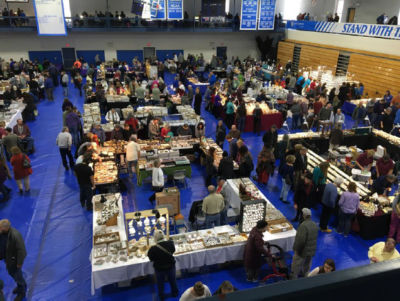 In April of 2018, PID branched out a bit and became a first-time vendor at the Maine Mineralogical & Geological Society’s (MMGS’s) Annual Gem, Mineral, & Jewelry Show. Held here at Saint Joseph’s College in the Alfond Center, roughly 4,500 people attended the show that weekend. PID reported great exposure and decent sales.
In April of 2018, PID branched out a bit and became a first-time vendor at the Maine Mineralogical & Geological Society’s (MMGS’s) Annual Gem, Mineral, & Jewelry Show. Held here at Saint Joseph’s College in the Alfond Center, roughly 4,500 people attended the show that weekend. PID reported great exposure and decent sales.
Workers
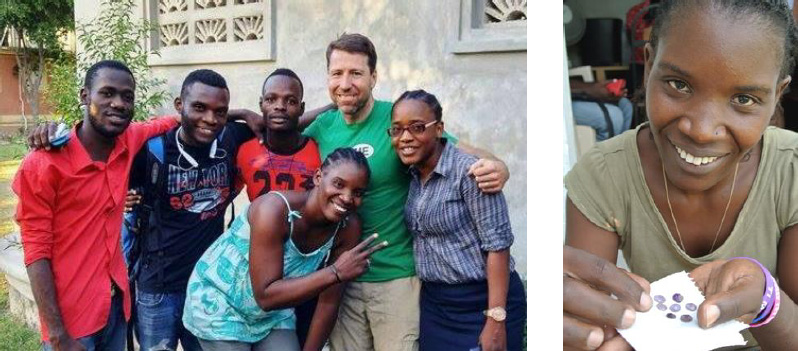 With the physical groundwork being laid for our small business initiative, the other major task to accomplish was to organize our workforce and establish a fair wage system. Since the beginning of this project in 2014, I’ve taught more than a dozen Haitians how to facet gemstones. But given the numerous variables at play in Haiti, it is difficult to retain workers. Major life changes are common: some get ill, move away, get other jobs, or are forced to shoulder other family responsibilities. However, we had a solid crew of three who had stuck with it from the start, and of those three, Michaelange proved to be the most skilled. It was decided, therefore, to make her Supervisor of the LAC. She was given a contract with a good annual salary. She would be expected to work at least 40 hours a week cutting gemstones; filling orders; inventorying and reordering supplies; recruiting, training, and scheduling workers; overseeing quality control; and overseeing the safety, cleanliness, and accessibility of the LAC. She was thrilled with this appointment, and I rested easier knowing that this enterprise was in good hands. For the other workers, we established three levels of competency (basic, intermediate, and advanced) with corresponding benchmarks and pay scales. Beyond a basic wage, the better one became at gem cutting, the more they could earn doing it.
With the physical groundwork being laid for our small business initiative, the other major task to accomplish was to organize our workforce and establish a fair wage system. Since the beginning of this project in 2014, I’ve taught more than a dozen Haitians how to facet gemstones. But given the numerous variables at play in Haiti, it is difficult to retain workers. Major life changes are common: some get ill, move away, get other jobs, or are forced to shoulder other family responsibilities. However, we had a solid crew of three who had stuck with it from the start, and of those three, Michaelange proved to be the most skilled. It was decided, therefore, to make her Supervisor of the LAC. She was given a contract with a good annual salary. She would be expected to work at least 40 hours a week cutting gemstones; filling orders; inventorying and reordering supplies; recruiting, training, and scheduling workers; overseeing quality control; and overseeing the safety, cleanliness, and accessibility of the LAC. She was thrilled with this appointment, and I rested easier knowing that this enterprise was in good hands. For the other workers, we established three levels of competency (basic, intermediate, and advanced) with corresponding benchmarks and pay scales. Beyond a basic wage, the better one became at gem cutting, the more they could earn doing it.
Student Impact
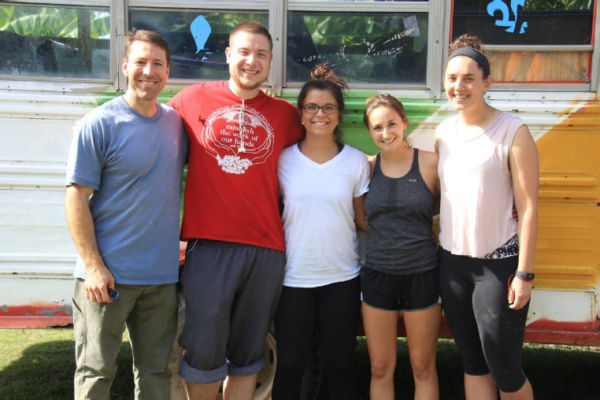 I was not the only SJC member to remain in Haiti for back-to-back trips that year. Four students opted to join me for the full two-week experience. Two of them, Primo Lombardi (’18) and Sami Pinard (’19), had such profound experiences that they both now work for PID. Primo has been overseeing some of PID’s work in Peru and Mississippi, and Sami has been tapped to help out in Haiti and Guatemala. A third student, Sarah Comtois (’18) utilized her time to shoot over 100 hours of film (including areo-drone shots) for her senior Communications project. Throughout her Spring semester, she then compiled and edited her raw footage into a 23-minute documentary titled Facets of Haiti. This first-rate production conveys the vital work that PID is doing in Haiti (including this small-business initiative) and features various members of the SJC community. It also helped launch Sarah’s career; upon graduation she was immediately hired by News Center Maine, Portland’s NBC-affiliate. The fourth student, Abby Gummoe (’20), wound up participating in a total of 6 International Service Trips during her four years at SJC. She recently graduated from the Nursing Program and accepted a position at Vanderbilt Ingram Cancer Center in Nashville, Tennessee. Despite the move, Abby has vowed to return to Maine over Christmas Break to help chaperone future SJC Service Trips.
I was not the only SJC member to remain in Haiti for back-to-back trips that year. Four students opted to join me for the full two-week experience. Two of them, Primo Lombardi (’18) and Sami Pinard (’19), had such profound experiences that they both now work for PID. Primo has been overseeing some of PID’s work in Peru and Mississippi, and Sami has been tapped to help out in Haiti and Guatemala. A third student, Sarah Comtois (’18) utilized her time to shoot over 100 hours of film (including areo-drone shots) for her senior Communications project. Throughout her Spring semester, she then compiled and edited her raw footage into a 23-minute documentary titled Facets of Haiti. This first-rate production conveys the vital work that PID is doing in Haiti (including this small-business initiative) and features various members of the SJC community. It also helped launch Sarah’s career; upon graduation she was immediately hired by News Center Maine, Portland’s NBC-affiliate. The fourth student, Abby Gummoe (’20), wound up participating in a total of 6 International Service Trips during her four years at SJC. She recently graduated from the Nursing Program and accepted a position at Vanderbilt Ingram Cancer Center in Nashville, Tennessee. Despite the move, Abby has vowed to return to Maine over Christmas Break to help chaperone future SJC Service Trips.
Academic Year 2018-19
Machine #2
Rather than offering back-to-back International Service Trips in AY 2018-19, we decided to offer one before Christmas and another after New Year’s. Camilla and I decided that I would lead the pre-Christmas trip to Haiti, and she would lead the post-New Year’s trip to Guatemala. My primary agenda for this trip was to deliver and set up a new machine. It was hoped that this new machine would effectively double our gemstone production.
In my original grant, I proposed that PID pay for this second machine. Turns out, they didn’t have to. As the crowds at MMGS’s Gem, Mineral, & Jewelry Show had grown larger and larger over the years, so had the revenue from sales at the concession stand. In the past, we had always donated these funds to PID’s child sponsorship programs in Haiti and Guatemala. But we had done so well with the 2017 and 2018 Shows that we were able to use our surplus funds (around $3,500) to purchase a second machine for PID’s small business initiative.
Diverted funds
The MMGS donation proved to be fortuitous since, during the 2018-19 AY, I found myself suddenly in charge of a tenure-track search for our Department of Theology. The Annual Meeting of the American Academy of Religion (AAR) and the Society of Biblical Literature (SBL), an event that would draw tens of thousands of theologians to Denver, Colorado, was scheduled for November. Our department sought to interview candidates there, but I was ineligible to access the money that I would normally draw upon to attend this conference because of my Professorship Award. Therefore, I sought and received permission from both SJC and PID to use around $1,700 of my Professorship Award funds to cover my conference costs. As it turned out, this was a good call. I was able to interview the majority of our top candidates face to face there, including our ultimate hire, Dr. Jeffrey Morgan.
Production
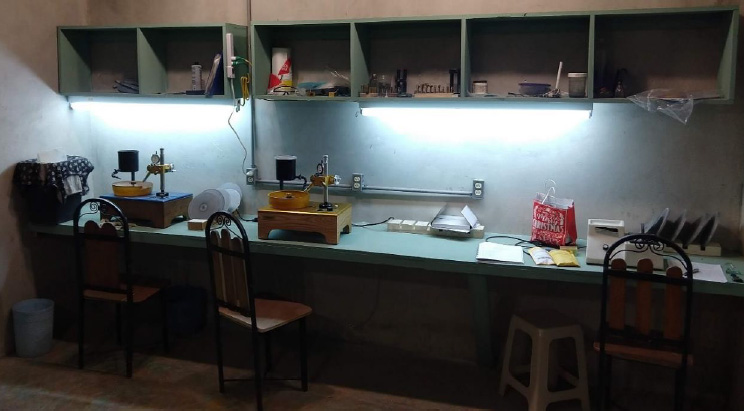 Once in Haiti, I was able to set up the second machine and we went to work. Unfortunately, we had lost two of our more seasoned workers, Jean Philippe and Noel. They were replaced by some new recruits, which slowed the process. Nevertheless, the second machine did indeed double our capacity. In just one week, we produced 17 gems. Although the workers had been using the LAC since April, this was, of course, the first time that I had the opportunity to see and experience it for myself. It was incredible—a million times better than the dank, dark, and cramped depot that we had been using!
Once in Haiti, I was able to set up the second machine and we went to work. Unfortunately, we had lost two of our more seasoned workers, Jean Philippe and Noel. They were replaced by some new recruits, which slowed the process. Nevertheless, the second machine did indeed double our capacity. In just one week, we produced 17 gems. Although the workers had been using the LAC since April, this was, of course, the first time that I had the opportunity to see and experience it for myself. It was incredible—a million times better than the dank, dark, and cramped depot that we had been using!
Ads & Promotional Expenses
With the second machine up and operational, PID decided to invest more in marketing and advertising our product. Thus, the bulk of the remaining grant funding that year (around $1,800) went towards promotional materials, ads, business cards, boxes, etc. As with 2018, the grant also paid the dealer fees for PID at the MMGS Annual Gem, Mineral & Jewelry Show in April of 2019. This year, sales were even better as PID was becoming more and more adept at presenting their product at various craft and trade shows.
Political Instability
I didn’t realize it at the time, but my AY 2018-19 trip would prove to be my last one to Haiti for a while. Less than two months after our teams left, the political situation in Haiti rapidly deteriorated as protests and manifestations (mostly nonviolent, but some less so) grew larger and more frequent. Main roads around the capital were barricaded as political activists and agitators sought to impose mandatory shutdowns. The US State Department issued a Level 3 travel warning urging all US citizens to reconsider travel to the country. To their credit, PID cancelled all of its scheduled trips to Haiti, but they were able to keep their essential services (namely, their medical clinic and child sponsorship program) operating with the local staff and directors. Fortunately, because Michaelange and her gem cutters lived close to PID’s compound, they, too, were able to continue their work.
And Out of the Blue, A Very Generous Offer…
On July 13, 2019, I received the following email from James Ward in Australia:
Hello,
I am an academic, researcher and activist with a strong interest in sustainability, equity and the “wellbeing economy”. I am also soon to be in the market for an engagement ring. My partner is also an active permacultirist, sustainability advocate and zero-waste activist. ☺
So naturally, having recently found out about PID and PID Crafts, I am very excited by the possibility of sourcing an engagement ring from using recycled glass-based gems from Haiti. This just seems a beautiful alternative to mining diamonds, in so many ways.
From your website I note that your artist, Michaelange Antoine, has a desire to expand her glass gem-cutting program through the purchase of an additional gem-cutting machine. So it strikes me that, rather than spending $X thousand on a diamond, there may be a better allocation of money towards a donation of a similar magnitude that has lasting impact on this wonderful, high-impact small business enterprise, and in so doing, as a side effect I might procure an engagement ring that contains a gem from recycled glass, which carries a far more valuable story than any diamond ever could.
So… I would like to enquire as to the specific possibility of my donating a gem-cutting machine to the Haiti-based glass gem business, in exchange for a custom engagement ring. Depending on the type of machine Michaelange requires for her business, it may or may not be within my budget (I am just an academic after all!). But I would really like to try this…! ☺
I would be very happy to discuss possibilities, costs and logistics over Skype (I am based in Adelaide, Australia) or Zoom, or just on the phone. Or else email is fine.
Warmest regards, James Ward
We were excited to partner with James to make this project happen. However, it wasn’t easy. James originally wanted a heart-shaped gem—something that Michaelange had never cut before. Because of the political situation, I wasn’t able to travel to Haiti to show her how to do it. Instead, I did my best to coach her through it over the phone; the rest she had to figure out through trial and error. Eventually she succeeded and we sent two such gems to James. However, the Australian jeweler he was working with determined that a round brilliant gem would be a better fit for James’s customized setting. In the meantime, the situation in Haiti had deteriorated so badly that shipping the gems out of the country was no longer possible. Finally, Gale Hull (PID’s founder and President) flew to the Port au Prince airport where she was able to deliver some supplies and pick up the gems without ever leaving the terminal. By early December, James’s jeweler had received the gems and set one of them into a beautiful engagement ring for his fiancée, Keri. He popped the question on December 19th, and, of course, she said YES! James made good on his promise to fund another machine. He wired the money directly to PID; technically, this would be machine #4.
Academic Year 2019-20
Machine #3
I used the bulk of the third year’s grant money to purchase our third faceting machine and its associated supplies. I intended to bring it down to Haiti and set it up in December of 2019 or January of 2020, but the political situation forced us to cancel our trips. In February, I learned that PID’s Chief of Security was visiting family in Florida. If I could get the machine to him there, he could deliver it to the compound in Haiti for us. So in late February, I shipped it to him in Florida. Then the pandemic hit.
COVID-19 Pandemic
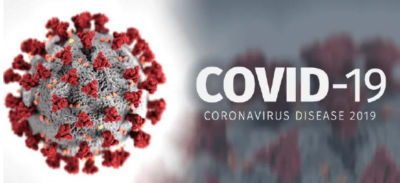 In early March, with COVID-19 rapidly spreading throughout the world, and little improvement in Haiti’s political situation, the US State Department issued a Level 4 – Do Not Travel Warning to its citizens. Haiti shut down its main airport in Port-au-Prince, and no commercial flights have been allowed in or out since. PID’s Chief of Security remains in Florida with the third machine--and a slew of rebooked airline tickets. He remains determined to deliver the third machine as soon as commercial airline travel resumes. (Needless to say, because of these factors the SJC International Service Trips to Haiti for the 20-21 AY have been cancelled.)
In early March, with COVID-19 rapidly spreading throughout the world, and little improvement in Haiti’s political situation, the US State Department issued a Level 4 – Do Not Travel Warning to its citizens. Haiti shut down its main airport in Port-au-Prince, and no commercial flights have been allowed in or out since. PID’s Chief of Security remains in Florida with the third machine--and a slew of rebooked airline tickets. He remains determined to deliver the third machine as soon as commercial airline travel resumes. (Needless to say, because of these factors the SJC International Service Trips to Haiti for the 20-21 AY have been cancelled.)
Stolen Gems
Around this same time (Jan 2020), we had placed a large gem order with Michaelange in anticipation of April’s MMGS Gem, Mineral and Jewelry Show. The workers had finished around 60 pieces and sent them via DHL. (Thus far, DHL had proven a fairly reliable means of shipping.) Without thinking, they described them in the requisite paperwork as “Gems.” Of course, this description proved too tempting for some DHL handler. The package was sliced open and all of the gems were stolen; nothing but an empty envelope arrived in the US.

Feeling panicked and under a time-crunch, Michaelange and the workers redoubled their efforts. They immediately went back to work and cut another 90 gems. They had no choice but to ship them via DHL, but this time, they described them as “Glass Craft Samples.” This strategy proved successful, and they arrived safely in the US in early March. Camilla immediately went to work setting them for the MMGS Show in April. However, thanks to the COVID-19 pandemic, that Show was first postponed until October 2020, and has ultimately been rescheduled for April 2021.
Yet Another Generous Donation
Mary Foster, a dear friend of mine from Milwaukee, WI, had been impressed with all of the work we had been doing in Haiti and she wanted to help. Decades ago, when she was a college student, she spent a semester in South America. During her time there, she was gifted a collection of 20 or so unset precious Brazillian gemstones: emeralds, aquamarines, morganites, amethysts, citrines, and even a ruby. These she generously donated to our small business initiative. In February of 2020, we had them appraised by a trusted jeweler, who set the retail value at around $4,500. Camilla set them, hoping to feature them at the MMGS Show in April. But with the cancellation of that event, we shipped them to PID to offer on their ETSY site. Sales of these pieces are reported to be strong.
More Workers (Glass Pickers) Added
Despite the COVID pandemic, the gem cutting continues. However, since the inception of this program, the supply of raw source material has diminished. That’s not to say that there isn’t plenty of discarded glass in Haiti to cut and polish. Clear, greens, and browns are plentiful. But the more desirable colors—aqua, yellow, red, orange, cobalt, and lavender—are getting harder to find. So in April of 2020 I proposed that PID pay some of the local women in Molieur, a squatters community inhabiting a large landfill (and the site of PID’s mobile medical clinic in Sarah Comtois’ Facets of Haiti documentary), to comb through the trash to find more glass. Turns out, the timing was perfect. Since the COIVD crisis has made their meagre salvage gigs even less profitable, the women welcomed this opportunity. We have now added four glass pickers to our workforce and are already seeing a plentiful supply of gorgeous new colors.
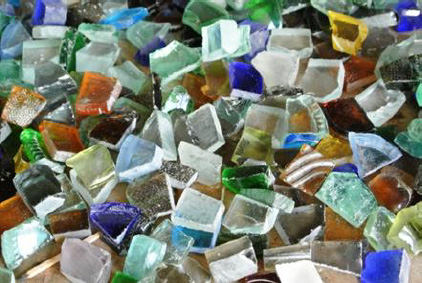
USFG Competition & Certification
The United States Faceting Guild is the official organization of this trade in the US, with thousands of members. Each year it offers a Gemstone Cutting Competition for four skill levels: Novice, Pre-Master, Master, and Grand Master. Participants are given a corresponding design with instructions indicating source material and allowable specifications for gem size and girdle width. Finished gems are then sent to a judge who critiques and scores the work. If the work exceeds a minimum score, official certification is granted by the USFG for that level of competency. However, only one gemstone can be submitted per member per year. This year’s deadline for submission is August 30th.
With the COVID economic lull, I put Michaelange and Minouche to work on cutting their own submissions. Coincidentally, the design chosen for this year’s Novice category is one that they both have a lot of experience with. I’m looking forward to having their work assessed by an impartial judge. If they can earn Novice certification this year, they can then go on to compete at the Pre-Master level next year. Such certification will not only bring validation to their skills as individuals, but an added degree of professionalism to this small business initiative.
Contract work for Gift of Hope Haiti
Finally, on June 4th of this year, I was contacted by Mallery Neptune, Founder and Director of Gift of Hope Haiti. Gift of Hope is an ethical fashion initiative that is both socially responsible and environmentally conscious. Seeking to break the cycle of poverty through job creation, they employ over 70 Haitians and pay a living wage that is at least three times the minimum wage. While in Haiti, Mallery had heard about our gemstone project and wondered if we might be interested in creating some pieces which would match their logo for a line of bracelets and earrings.
 Of course we were interested; but this project was not easy. The Gift of Hope logo (above) is deceptively simple; it involves some really sharp edges and steep angles. I had to not only create a design that resembled the logo, but it also had to withstand a small vertical borehole that Mallery wanted drilled through the middle of it. This hole would permit us to thread a wire through the gem to secure it to the metal band of the bracelet or the hooks of the earrings. I designed two different versions of the logo and then cut 7 different prototypes in order to provide some sample variations. I also had a 1.0mm borehole drilled through one of the prototypes just to be sure that the design could accommodate it. (It could.)
Of course we were interested; but this project was not easy. The Gift of Hope logo (above) is deceptively simple; it involves some really sharp edges and steep angles. I had to not only create a design that resembled the logo, but it also had to withstand a small vertical borehole that Mallery wanted drilled through the middle of it. This hole would permit us to thread a wire through the gem to secure it to the metal band of the bracelet or the hooks of the earrings. I designed two different versions of the logo and then cut 7 different prototypes in order to provide some sample variations. I also had a 1.0mm borehole drilled through one of the prototypes just to be sure that the design could accommodate it. (It could.)
Mallery received the prototypes on June 28th. She was very excited about them and is interested in moving this project forward. She had mentioned to PID that, if all went well, they would be looking to place an initial order of approximately 600 gems. Needless to say this opportunity has the potential to take our small business initiative to the next level. It would certainly provide a steady source of work and income for all of gem cutters and glass pickers for the foreseeable future.
Conclusion
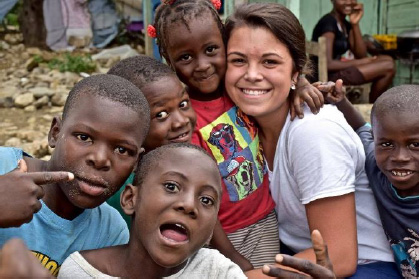 I think what I appreciate most about this initiative is that it broadly exemplifies many of the hallmarks of what SJC, at its best, aspires to promote. At its heart is a Mission-driven agenda to faithfully put Jesus’s Gospel message into practice: namely, that by demonstrating a deep and genuine compassion for the poor and disenfranchised, we demonstrate our deep and genuine love for him. From the bedrock of this foundation, a variety of desirable outcomes have emerged. We have developed a highly resilient, economically sustainable, and environmentally friendly small business enterprise. We have overcome enormous challenges with creative determination and entrepreneurial innovation. We have engaged our students and transformed their lives, inspiring them to likewise become agents of positive change in our world. We have ignited the compassion of onlookers and outsiders, who have responded in kind with radical, selfless generosity. And we have modeled true advocacy for the marginalized—the victims of geo-political, racial, and gender inequities. While there is certainly more work to be done, I submit that all of these things are cause for celebration. Indeed, they are the returns on an investment that SJC can rightfully take pride in.
I think what I appreciate most about this initiative is that it broadly exemplifies many of the hallmarks of what SJC, at its best, aspires to promote. At its heart is a Mission-driven agenda to faithfully put Jesus’s Gospel message into practice: namely, that by demonstrating a deep and genuine compassion for the poor and disenfranchised, we demonstrate our deep and genuine love for him. From the bedrock of this foundation, a variety of desirable outcomes have emerged. We have developed a highly resilient, economically sustainable, and environmentally friendly small business enterprise. We have overcome enormous challenges with creative determination and entrepreneurial innovation. We have engaged our students and transformed their lives, inspiring them to likewise become agents of positive change in our world. We have ignited the compassion of onlookers and outsiders, who have responded in kind with radical, selfless generosity. And we have modeled true advocacy for the marginalized—the victims of geo-political, racial, and gender inequities. While there is certainly more work to be done, I submit that all of these things are cause for celebration. Indeed, they are the returns on an investment that SJC can rightfully take pride in.
Finally, I wish to conclude by thanking the members of the 2016-17 Faculty Development Committee, the Assistant Dean at that time (Patricia Ireland), and the Chief Academic Officer, Dr. Michael Pardales for selecting my proposal and extending to me the opportunity to pursue this pipedream of mine. I also want to extend my gratitude to Gale Hull for her enthusiastic encouragement and support of this project from its inception. I feel deeply indebted to SJC, the MMGS, James Ward, and Mary Foster for their exceptionally generous contributions to this initiative. I am also grateful for the many SJC students who participated in our International Service Trips to Haiti and cheerfully volunteered hundreds of hours of their sweat equity. I want to thank all of the gem cutters who have patiently endeavored to learn the trade, and especially Michaelange for her steadfast commitment to this small business initiative. And last, but certainly not least, I want to acknowledge my wife Camilla. Not only has she played an instrumental role in setting our gemstones, she has also graciously gifted me considerable time to devote to this cause. I’ve been richly blessed to be a part of it, and I’m excited to see where it goes from here!

